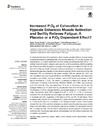Please use this identifier to cite or link to this item:
https://accedacris.ulpgc.es/jspui/handle/10553/44471
| Title: | Increased PIO2 at exhaustion in hypoxia enhances muscle activation and swiftly relieves fatigue: a placebo or a PIO2 dependent effect? | Authors: | Torres-Peralta, Rafael Losa Reyna,Jose Morales-Alamo, David González-Izal, Miriam Perez Suárez,Ismael Ponce-González, Jesús G. Izquierdo, Mikel Calbet, José A.L. |
UNESCO Clasification: | 241110 Fisiología del músculo | Keywords: | Fatigue Performance Hypoxia Altitude Muscle activation, et al |
Issue Date: | 2016 | Publisher: | 1664-042X | Journal: | Frontiers in Physiology | Abstract: | © 2016 Torres-Peralta, Losa-Reyna, Morales-Alamo, González-Izal, Pérez-Suárez, Ponce-González, Izquierdo and Calbet.To determine the level of hypoxia from which muscle activation (MA) is reduced during incremental exercise to exhaustion (IE), and the role played by PIO2 in this process, ten volunteers (21 ± 2 years) performed four IE in severe acute hypoxia (SAH) (PIO2 = 73 mmHg). Upon exhaustion, subjects were asked to continue exercising while the breathing gas mixture was swiftly changed to a placebo (73 mmHg) or to a higher PIO2 (82, 92, 99, and 142 mmHg), and the IE continued until a new exhaustion. At the second exhaustion, the breathing gas was changed to room air (normoxia) and the IE continued until the final exhaustion. MA, as reflected by the vastus medialis (VM) and lateralis (VL) EMG raw and normalized root mean square (RMSraw, and RMSNz, respectively), normalized total activation index (TAINz), and burst duration were 8-20% lower at exhaustion in SAH than in normoxia (P < 0.05). The switch to a placebo or higher PIO2 allowed for the continuation of exercise in all instances. RMSraw, RMSNz, and TAINz were increased by 5-11% when the PIO2 was raised from 73 to 92, or 99 mmHg, and VL and VM averaged RMSraw by 7% when the PIO2 was elevated from 73 to 142 mmHg (P < 0.05). The increase of VM-VL average RMSraw was linearly related to the increase in PIO2, during the transition from SAH to higher PIO2 (R2 = 0.915, P < 0.05). In conclusion, increased PIO2 at exhaustion reduces fatigue and allows for the continuation of exercise in moderate and SAH, regardless of the effects of PIO2 on MA. At task failure, MA is increased during the first 10 s of increased PIO2 when the IE is performed at a PIO2 close to 73 mmHg and the PIO2 is increased to 92 mmHg or higher. Overall, these findings indicate that one of the central mechanisms by which severe hypoxia may cause central fatigue and task failure is by reducing the capacity for reaching the appropriate level of MA to sustain the task. The fact that at exhaustion in severe hypoxia the exercise was continued with the placebo-gas mixture demonstrates that this central mechanism has a cognitive component. | URI: | https://accedacris.ulpgc.es/handle/10553/21253 | ISSN: | 1664-042X | DOI: | 10.3389/fphys.2016.00333 | Source: | Frontiers in Physiology[EISSN 1664-042X],v. 7, (Agosto 2016) | Rights: | by-nc-nd |
| Appears in Collections: | Artículos |
SCOPUSTM
Citations
12
checked on Jun 8, 2025
WEB OF SCIENCETM
Citations
11
checked on Jun 8, 2025
Page view(s)
25
checked on Sep 2, 2023
Download(s)
18
checked on Sep 2, 2023
Google ScholarTM
Check
Altmetric
Share
Export metadata
Items in accedaCRIS are protected by copyright, with all rights reserved, unless otherwise indicated.
